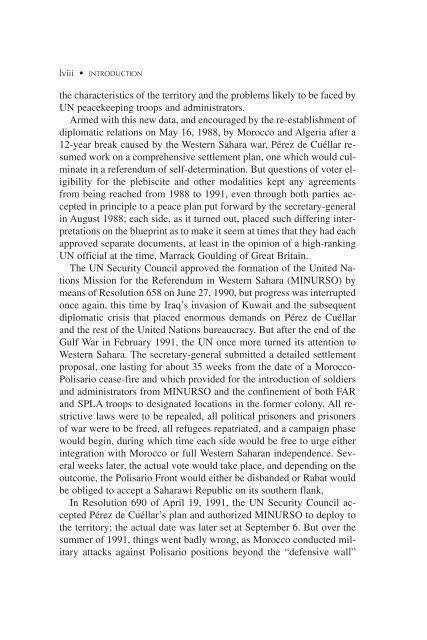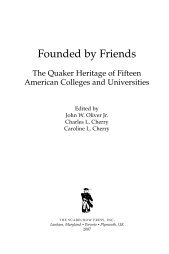Historical Dictionary of Western Sahara Third ... - Scarecrow Press
Historical Dictionary of Western Sahara Third ... - Scarecrow Press
Historical Dictionary of Western Sahara Third ... - Scarecrow Press
You also want an ePaper? Increase the reach of your titles
YUMPU automatically turns print PDFs into web optimized ePapers that Google loves.
lviii • INTRODUCTION<br />
the characteristics <strong>of</strong> the territory and the problems likely to be faced by<br />
UN peacekeeping troops and administrators.<br />
Armed with this new data, and encouraged by the re-establishment <strong>of</strong><br />
diplomatic relations on May 16, 1988, by Morocco and Algeria after a<br />
12-year break caused by the <strong>Western</strong> <strong>Sahara</strong> war, Pérez de Cuéllar resumed<br />
work on a comprehensive settlement plan, one which would culminate<br />
in a referendum <strong>of</strong> self-determination. But questions <strong>of</strong> voter eligibility<br />
for the plebiscite and other modalities kept any agreements<br />
from being reached from 1988 to 1991, even through both parties accepted<br />
in principle to a peace plan put forward by the secretary-general<br />
in August 1988; each side, as it turned out, placed such differing interpretations<br />
on the blueprint as to make it seem at times that they had each<br />
approved separate documents, at least in the opinion <strong>of</strong> a high-ranking<br />
UN <strong>of</strong>ficial at the time, Marrack Goulding <strong>of</strong> Great Britain.<br />
The UN Security Council approved the formation <strong>of</strong> the United Nations<br />
Mission for the Referendum in <strong>Western</strong> <strong>Sahara</strong> (MINURSO) by<br />
means <strong>of</strong> Resolution 658 on June 27, 1990, but progress was interrupted<br />
once again, this time by Iraq’s invasion <strong>of</strong> Kuwait and the subsequent<br />
diplomatic crisis that placed enormous demands on Pérez de Cuéllar<br />
and the rest <strong>of</strong> the United Nations bureaucracy. But after the end <strong>of</strong> the<br />
Gulf War in February 1991, the UN once more turned its attention to<br />
<strong>Western</strong> <strong>Sahara</strong>. The secretary-general submitted a detailed settlement<br />
proposal, one lasting for about 35 weeks from the date <strong>of</strong> a Morocco-<br />
Polisario cease-fire and which provided for the introduction <strong>of</strong> soldiers<br />
and administrators from MINURSO and the confinement <strong>of</strong> both FAR<br />
and SPLA troops to designated locations in the former colony. All restrictive<br />
laws were to be repealed, all political prisoners and prisoners<br />
<strong>of</strong> war were to be freed, all refugees repatriated, and a campaign phase<br />
would begin, during which time each side would be free to urge either<br />
integration with Morocco or full <strong>Western</strong> <strong>Sahara</strong>n independence. Several<br />
weeks later, the actual vote would take place, and depending on the<br />
outcome, the Polisario Front would either be disbanded or Rabat would<br />
be obliged to accept a <strong>Sahara</strong>wi Republic on its southern flank.<br />
In Resolution 690 <strong>of</strong> April 19, 1991, the UN Security Council accepted<br />
Pérez de Cuéllar’s plan and authorized MINURSO to deploy to<br />
the territory; the actual date was later set at September 6. But over the<br />
summer <strong>of</strong> 1991, things went badly wrong, as Morocco conducted military<br />
attacks against Polisario positions beyond the “defensive wall”
















